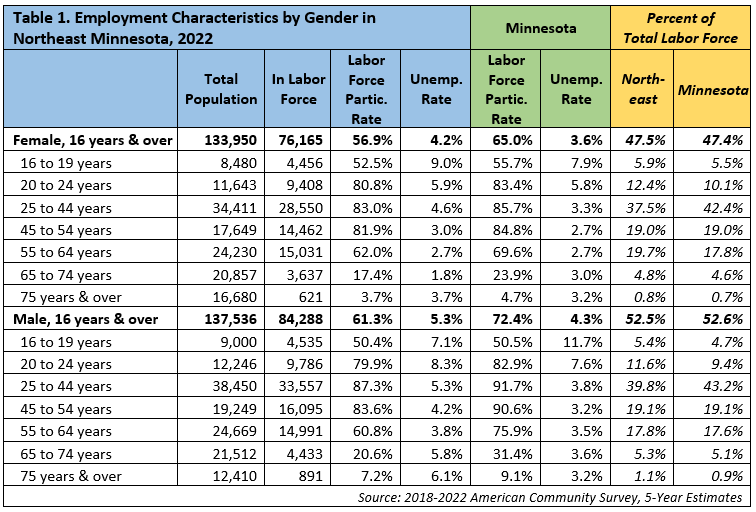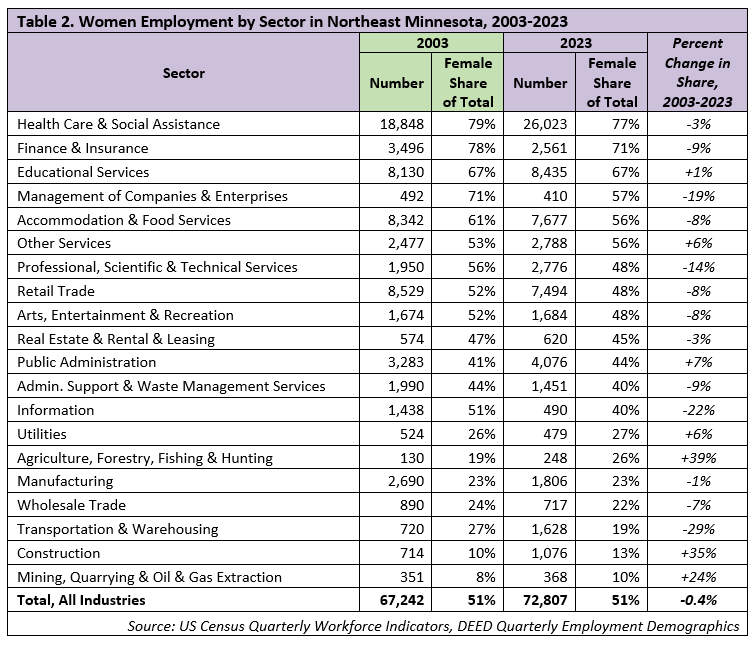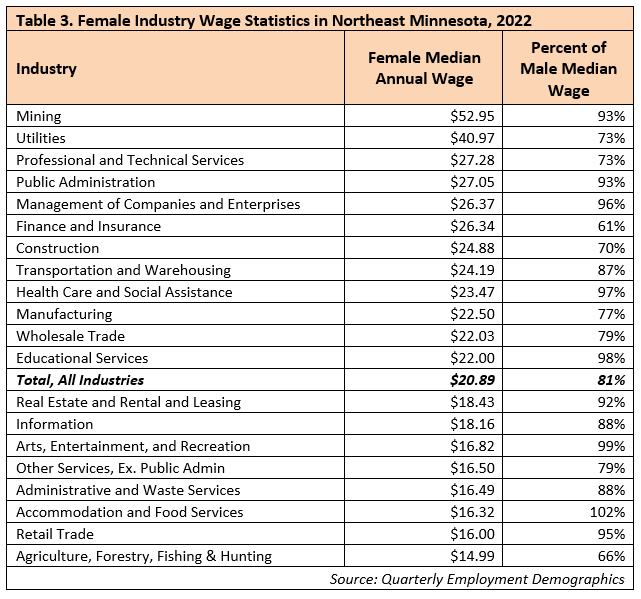 Home to the state's second-largest metro, the Northeast Region has a strong industrial sector, tied largely to the area's abundant natural resources.
Home to the state's second-largest metro, the Northeast Region has a strong industrial sector, tied largely to the area's abundant natural resources.
Most of the manufacturing base centers on mining and forest products industries. More than half of the sector's employment is in paper and machinery manufacturing.
Want the freshest data delivered by email? Subscribe to our regional newsletters.
3/26/2024 1:23:13 PM
Carson Gorecki
In celebration of Women's History Month, here is a (brief) history of women in the workforce in Northeast Minnesota using Census data. Women are slightly less likely to be in the labor force (employed or actively looking for work) than men (see Table 1). However, for the women that are in the labor force, they are less likely to be unemployed than their male counterparts. The unemployment rate for women in the region (4.2%) was nearly a full percentage point less than that for men (5.3%) (see Table 1).
When you factor in age, young women (ages 16-24) are more likely to be in the labor force than men of the same age group. Women are also more likely than men to be in the labor force between the ages of 55 and 64, but less likely to be in the labor force during the "prime" working ages of 25-44 years. Those also happen to be the prime parenting years, and women are still more likely than men to be the primary providers of childcare. For many women, not participating in the labor market is a choice, but for many others, the high cost and low availability of childcare is preventing them from working or working as much as they would like.

When we look at the number of jobs held by women, there is a slightly different story. Despite having lower participation rates and fewer people in the labor force, women hold more jobs than men in Northeast Minnesota. Other than 2015, women have had more jobs in the region than men every year since 2000. Part, but not all, of this flip can be explained by lower unemployment. The rest is likely due to women being more likely to hold multiple jobs.
Since 2019, female employment in the region (-6.4%) fell slightly more than male (-5.9%) employment, but has grown slightly faster since 2021. Over the past two decades there have been some notable re-arrangements in the gender employment patterns by sector. Health Care & Social Assistance remained the sector with both the highest share and number of women workers, even with a small decline in the female share (see Table 2). More than a third of all women workers were employed in Health Care & Social Assistance in 2023. A similar trend occurred in Finance & Insurance, which remains the sector with the second-highest share of female employment.
At the other end of the female employment spectrum are Mining and Construction. Both saw increases in the number and share of women workers. However, the Mining percent increase masks the relatively small absolute increase of 17 jobs over 20 years. The largest relative increase in female share occurred in Agriculture, Forestry, Fishing & Hunting, but again, the sector has relatively few workers over all.

Finally, there is the question of wages. Women in Northeast Minnesota make a median wage that is on average 81% that of men's (see Table 3). That share is up from 73% in 2003. As extensive research has shown, there are many reasons for this disparity, including occupational preference and segregation, the tendency to reward the ability to work long, inflexible schedules; family dynamics, discrimination and more. Claudia Goldin recently was awarded the Nobel prize in economics for her research on the subject. She predicted that as flexible schedules became more commonplace, women once locked out of greater participation (and promotion) were able to take advantage of new opportunities, continuing to close the gender pay gap.
In Northeast Minnesota, the gender wage gap was largest in Finance & Insurance, the sector with the second-highest (but declining) share of women workers. Agriculture, Forestry, Fishing & Hunting also had a sizable pay gap. The only sector where women were paid more than men was Accommodation & Food Services, the third-lowest median wage sector across all sectors. Wage gaps were smallest for Arts, Entertainment & Recreation, Educational Services, Health Care & Social Assistance, Management of Companies and Retail Trade. Of the six sectors with above average shares of female employment, four had smaller than average pay gaps (see Table 3).

While change is occurring, occupational and industrial employment and wage disparities by gender still exist in Northeast Minnesota. Many of the trends discussed above point to the continued need to highlight the opportunities available in industries that traditionally have not hired women in large numbers, such as Mining, Construction and Manufacturing.
Contact Carson Gorecki, Labor Market Analyst, at carson.gorecki@state.mn.us.